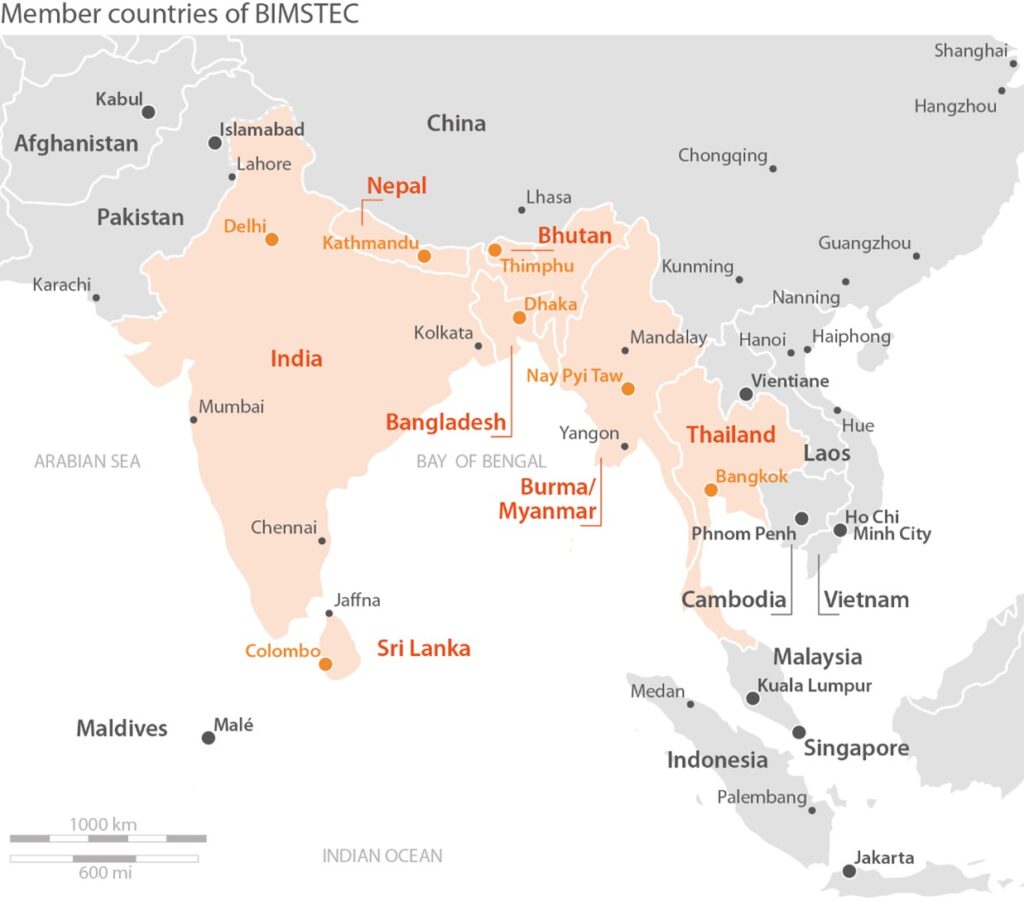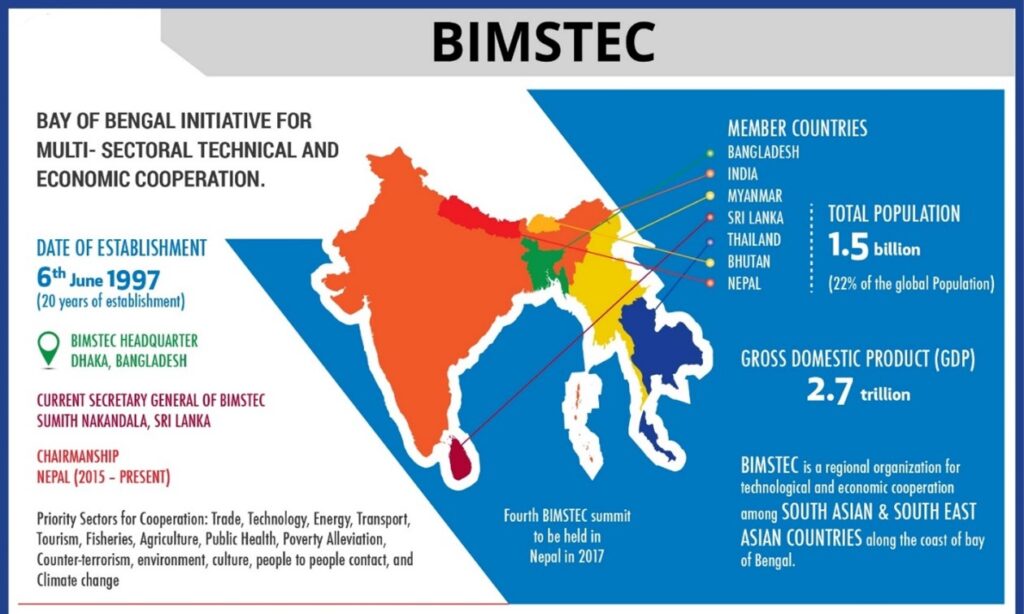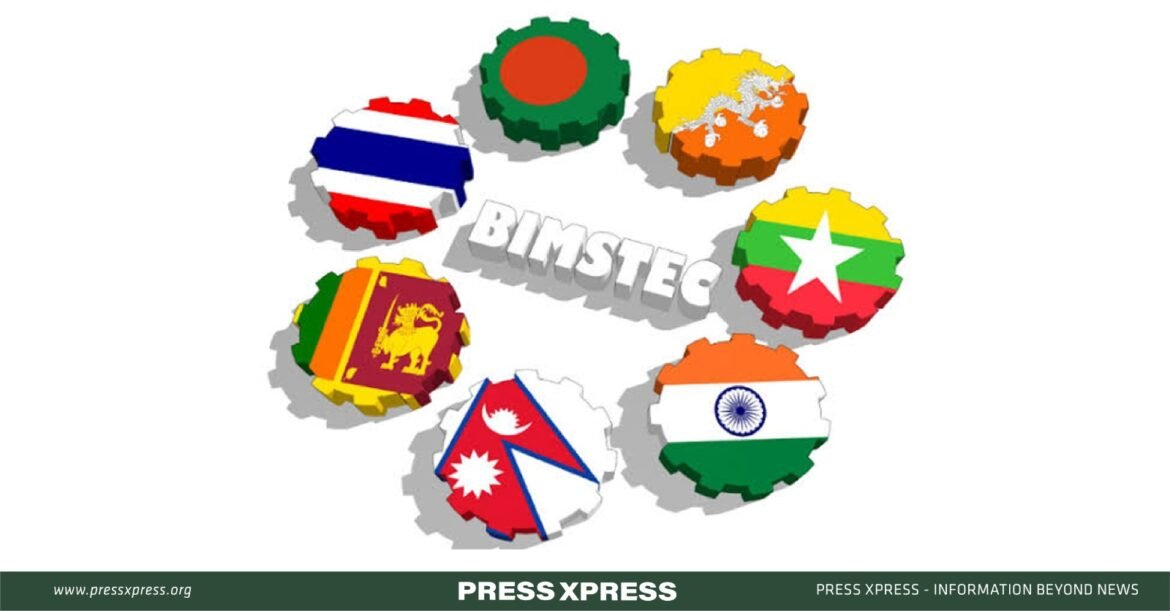At the intersection of South and Southeast Asia, a coalition of nations is forging deeper economic and technical ties. The Bay of Bengal Initiative for Multi-Sectoral Technical and Economic Cooperation, or BIMSTEC, unites seven countries – Bangladesh, India, Myanmar, Sri Lanka, Thailand, Bhutan and Nepal.
Conceived in 1997, the grouping aims to leverage its geographical proximity and pool resources across sectors like trade, technology, energy, and the environment. Bangladesh, strategically situated at the crossroads, has emerged as a pivotal player.
You Can Also Read: Bhutanese King Bolsters Friendship with Bangladesh
With an expanding economy and critical maritime gateways, Bangladesh is uniquely positioned to drive regional integration. Its efforts extend beyond bolstering its own prospects to advancing the collective development of BIMSTEC nations.
“Bangladesh can serve as a bridge, connecting South and Southeast Asia through enhanced cooperation and understanding,” said Farhan Uddin, an economist at Dhaka University. “Active Bangladeshi engagement could catalyze regional economic performance.”

From the bustling ports of Chattogram to the rural heartlands, there is palpable enthusiasm for BIMSTEC’s potential to unlock new growth frontiers. As the coalition deepens ties, the Bay of Bengal region could emerge as a powerhouse of trade and sustainable progress.
“Bangladesh and BIMSTEC will work together to achieve their common goals”
– Prime Minister Sheikh Hasina
When it was conceived in the final years of the 20th century (1997), the fledgling Bay of Bengal Initiative for Multi-Sectoral Technical and Economic Cooperation (Known then as BIST-EC) had a modest ambition: to nurture collaboration among the nations ringing the Bay of Bengal in just half a dozen sectors.
But as the new millennium dawned, BIMSTEC’s horizons broadened. By 2008, its areas of mutual endeavor had expanded to a robust 14, encompassing realms as diverse as trade, transport, energy, tourism, agriculture, public health, poverty reduction, law enforcement, environmental protection, cultural exchange, and presciently, climate change mitigation. The BIMSTEC Charter was signed and adopted during the Fifth BIMSTEC Summit held in virtual format in Colombo, Sri Lanka, on 30 March 2022
The evolution of this regional alliance from focused concord to multidimensional partnership mirrors the inexorable economic and social integration of South Asia and Southeast Asia. Each member state now leads concerted efforts in designated priority areas, their manifold initiatives embodying BIMSTEC’s comprehensive vision for uplifting the Bay of Bengal region through cross-border synergies.
How Big is BIMSTEC!
The Bay of Bengal Initiative for Multi-Sectoral Technical and Economic Cooperation (BIMSTEC) unites seven countries – Bangladesh, Bhutan, India, Myanmar, Nepal, Sri Lanka, and Thailand – in an alliance encompassing 1.73 billion people, nearly a quarter (22%) of the global population.

Their combined economy is vast. It reaches a total GDP of US$5.2 trillion as of 2023. This economic power shows BIMSTEC’s global significance. The group’s diverse economies range from agriculture to technology.
Each nation contributes uniquely to the group’s economy. India, with its large population and broad industrial base, stands out. Thailand’s tourism and manufacturing also boost the group’s economic profile. Bangladesh offers key shipping routes, a large agricultural base, and vital riverine shipping capability. Bhutan and Nepal add natural resources. Sri Lanka enhances maritime capabilities. BIMSTEC’s demographic and economic landscape is vast. It is vital for regional and global trade. The group’s collective economy and population have the potential to make it a significant player on the world stage.
BIMSTEC Eyes the Future
With an eye on developing the future economies of all member nations, BIMSTEC is focusing on the following key issues:
Trade and Investment:
- BIMSTEC emphasizes trade, investment, and connectivity.
- The BIMSTEC Leaders aim for an early conclusion of the BIMSTEC Free Trade Area (FTA) negotiations.
- Revitalizing BIMSTEC Business Forum and Economic Forum strengthens government-private sector cooperation.
- Seamless multi-modal transportation linkages are crucial for promoting trade and investment.
Connectivity:
- Prime Minister Narendra Modi highlighted the importance of various connectivity: trade, economic, transport, digital, and people-to-people.
- BIMSTEC focuses on developing highways, railways, waterways, sea routes, and airways in the region.
- The draft BIMSTEC Master Plan on Transport Connectivity is in progress.
Energy Grid Connectivity:
BIMSTEC Bank: The establishment of a BIMSTEC Bank could significantly contribute to the growth of the BIMSTEC economy. Here are some ways it can make an impact:
- By facilitating financial transactions, trade financing, and investment, the bank can strengthen economic ties among member countries.
- Improved financial infrastructure can enhance cross-border trade and investment flows.
Infrastructure Development:
- BIMSTEC faces an infrastructure investment gap of approximately $120 billion annually1.
- The bank could play a powerful role in financing infrastructure projects such as roads, railways, maritime ports, and airports.
Trade Facilitation:
- Simplified trade procedures and reduced transaction costs would boost intra-regional trade.
“To make BIMSTEC a real functional, the whole population needs the capacity to move freely across the region like Europe. Indeed, BIMSTEC Visa could be a great idea to implement. In addition, for the development progress, BIMSTEC Bank should evolve to channel funds to the right projects, and this banking system will largely help all seven member-states to get free from any tough conditions given by the World Bank and ADB.”-
– Mujtoba Ahmed Murshed, former advisor to the BIMSTEC Secretariat

BIMSTEC Visa
The BIMSTEC Visa has the potential to significantly contribute to the growth of the BIMSTEC economy. Like the Schengen visa, This Visa could facilitate easier movement of people across member countries to increase travel and tourism, enjoy jobs opportunities.
BIMSTEC Free Trade Area (FTA):
- Progressive elimination of tariffs and non-tariff barriers in substantially all trade in goods
- Progressive liberalization of trade in services with substantial sectoral coverage
- Establishing an open and competitive investment regime that facilitates and promotes investment within the BIMSTEC FTA.
BIMSTEC Tourism
BIMSTEC identified tourism as one of the areas of cooperation. The Nineteenth BIMSTEC Ministerial Meeting, conducted virtually on March 9, 2023, in Bangkok, Thailand, reiterated the importance of the tourism sector in strengthening historical, cultural, and economic ties within the region. It urged member states to promptly finalize the Plan of Action for tourism development and promotion, including the early establishment of the BIMSTEC Tourism Information Centre and utilization of the BIMSTEC Tourism Fund.
Intraregional Thematic Circuits:
Thematic tourist circuits can boost economic recovery from the pandemic. These circuits focus on themes such as wildlife, trekking, or religion. Initiatives include specialized tourist circuits (e.g., Buddhist Tourist Circuit, Temple Tourist Circuit), eco-tourism, and medical tourism.
In summary, BIMSTEC’s tourism circuit leverages its natural, cultural, and historical endowments to promote intra-regional tourism and attract visitors globally. People to People Contact:

BIMSTEC Technology Transfer Facility (TTF)
- Establish a BIMSTEC Technology Transfer Facility (TTF) in Sri Lanka facilitate the transfer of technologies among the BIMSTEC Member States.
- Focus on the following areas: Biotechnology, Nanotechnology, Information and Communication Technology, Space technology applications, Agriculture technology, Food Processing technology, Pharmaceutical technology, Automation, New and renewable energy technology, Oceanography, Nuclear Technology Applications, E-waste and solid waste management technology, Health technologies, Technologies pertinent to Disaster Risk Reduction and Climate Change Adaptation
In summary, BIMSTEC’s future lies in unlocking its economic potential, strengthening regional cooperation, and addressing infrastructure gaps. By fostering trade, investment, and connectivity, BIMSTEC can become a vibrant economic bloc in South and Southeast Asia.
BIMSTEC and Bangladesh
The country’s commitment to BIMSTEC is exemplified by hosting the organization’s permanent secretariat in Dhaka.
Bangladesh’s strategic location bridges nations across the Bay of Bengal, fostering collaboration for regional prosperity. Its experience with initiatives like SAARC and strong relations with India and China position it as a potential leader in expanding BIMSTEC’s scope. Bangladesh’s unique role highlights its capacity to significantly influence regional development and integration, effectively managing shared challenges and opportunities in the Bay of Bengal region.
Furthermore, the BIMSTEC Master Plan for Transport Connectivity underscores Bangladesh’s pivotal role in enhancing regional connectivity by improving transport infrastructure, facilitating trade and investment, and promoting integration. With its strategic positioning and proactive engagement, Bangladesh is poised to contribute significantly to fostering peace, prosperity, and sustainability in the Bay of Bengal region.
Conclusion
BIMSTEC offers Bangladesh numerous prospects, including increased trade and investment opportunities through enhanced connectivity with neighboring nations like Myanmar, a gateway to Southeast Asia. This regional cooperation can also facilitate Bangladesh’s access to energy resources, bolstering its energy security. The successful implementation of BIMSTEC agreements and initiatives can drive substantial economic growth, making it a crucial strategic partnership for Bangladesh.
Ultimately, BIMSTEC presents a valuable platform for Bangladesh to deepen regional engagement, address shared challenges, and unlock economic potential. By capitalizing on its strategic position and fostering cooperation within BIMSTEC, Bangladesh can contribute to and reap the benefits of the collective pursuit of peace, prosperity, and sustainable development in the region.


